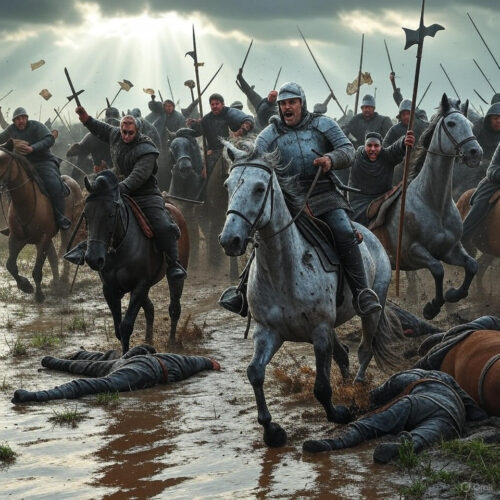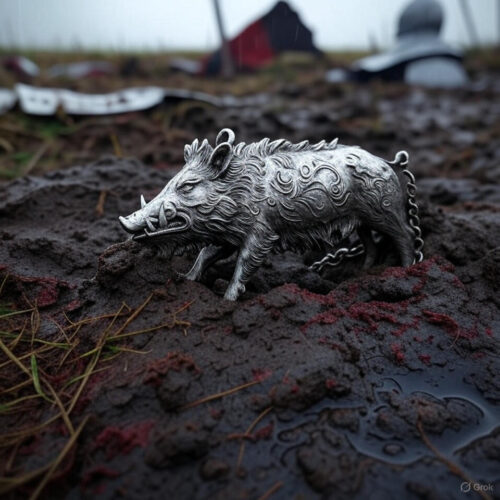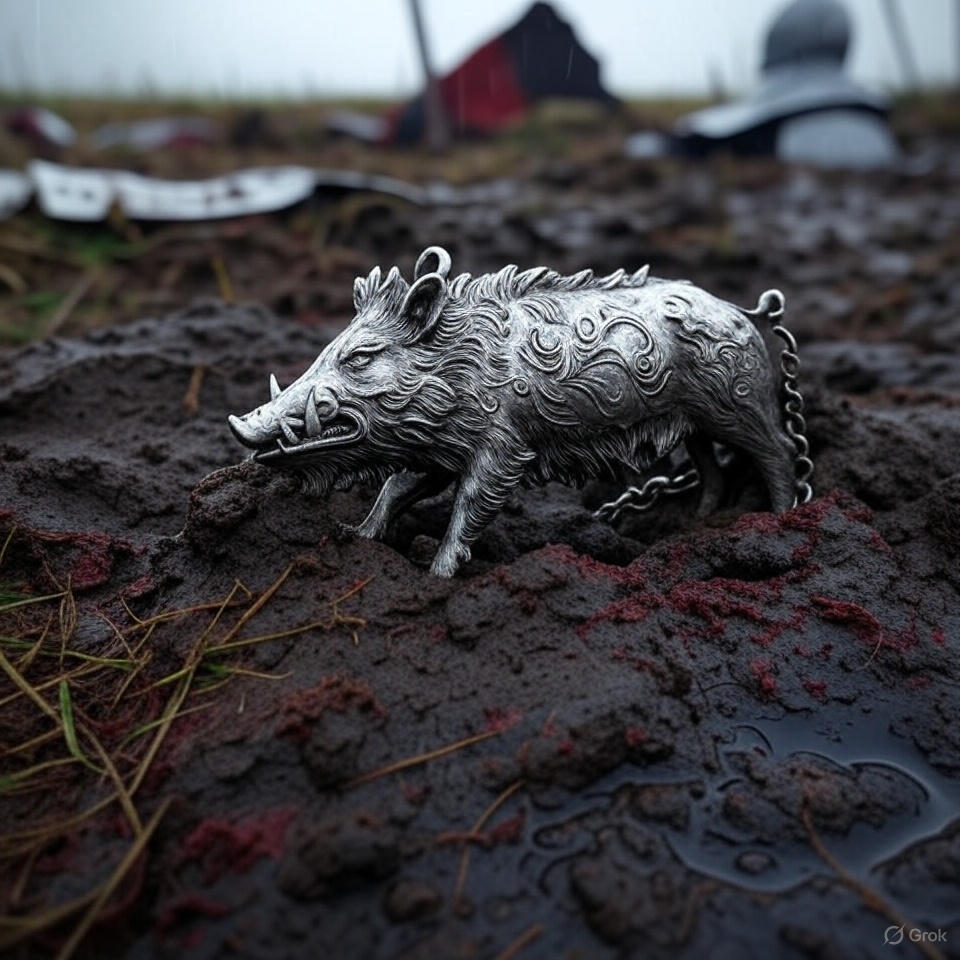The annals of history are filled with clashes that reshaped nations, and few are as dramatic as the Battle of Bosworth Field. Fought on August 22, 1485, this encounter not only ended a brutal civil war but also birthed a new era for England. Imagine a misty morning in Leicestershire, where the fate of a kingdom hung on the decisions of a few bold men, the swing of swords, and the unpredictable allegiance of armies. This wasn’t just a fight between two houses—the red rose of Lancaster and the white rose of York—but a culmination of decades of intrigue, betrayal, and ambition that had torn England apart. In this blog, we’ll dive deep into the historical tapestry of the Wars of the Roses, the key players who clashed on that fateful day, the blow-by-blow account of the battle, and its rippling aftermath. Then, we’ll bridge the centuries to see how the lessons from Bosworth can inspire and motivate you to conquer your own personal battles today. Prepare for a journey that’s equal parts thrilling history lesson and empowering call to action.
The Wars of the Roses, named retrospectively after the heraldic symbols of the rival houses, were a series of dynastic conflicts that ravaged England from 1455 to 1487. Rooted in the complex family tree of Edward III, who ruled from 1327 to 1377, the wars stemmed from competing claims to the throne. Edward’s sons and their descendants formed the branches: the House of Lancaster from John of Gaunt, Duke of Lancaster, and the House of York from Edmund of Langley, Duke of York. By the mid-15th century, England was weakened by the Hundred Years’ War with France, economic strife, and the mental instability of King Henry VI, a Lancastrian. Henry VI’s reign was marked by ineffectual governance, corruption among his advisors, and military defeats abroad, which fueled discontent among the nobility.
The spark ignited in 1455 at the First Battle of St Albans, where Richard, Duke of York, defeated Lancastrian forces and captured Henry VI. This set off a cycle of battles, including the brutal Lancastrian victory at Wakefield in 1460, where the Duke of York was killed, his head mockingly crowned with a paper crown. His son, Edward IV, avenged him at Towton in 1461, a bloodbath that saw up to 28,000 dead—the deadliest battle on English soil. Edward IV seized the throne, but the wars continued with shifting alliances. In 1469, the powerful Earl of Warwick, known as the “Kingmaker,” betrayed Edward IV and briefly restored Henry VI in 1470. Edward fought back, winning decisive victories at Barnet and Tewkesbury in 1471, where Henry VI’s son, Edward of Westminster, was killed, effectively extinguishing the direct Lancastrian line.
Edward IV’s death in 1483 plunged England into chaos again. His 12-year-old son, Edward V, was set to succeed him, but Richard, Duke of Gloucester—Edward IV’s brother—acted as protector. Richard quickly moved to consolidate power, arresting Edward V’s maternal relatives, the Woodvilles, and declaring Edward V and his brother illegitimate due to an alleged pre-contract of marriage by their father. The young princes were confined to the Tower of London and mysteriously disappeared, fueling rumors of murder that have haunted Richard’s reputation ever since. Richard was crowned Richard III in July 1483, but his reign was short and troubled. Rebellions erupted, including one led by Henry Stafford, Duke of Buckingham, in October 1483, which aimed to place Henry Tudor on the throne but was thwarted by bad weather and poor coordination. Buckingham was executed, and Henry Tudor, who had fled to Brittany after Tewkesbury, remained in exile, plotting his return.
Henry Tudor was an unlikely claimant. Born in 1457 to Margaret Beaufort, a Lancastrian descendant of John of Gaunt through the Beaufort line (which had been barred from the throne), and Edmund Tudor, Earl of Richmond, Henry spent much of his life in exile. Tutored by his uncle Jasper Tudor, he evaded Yorkist capture and sought refuge in Brittany, then France. His mother, Lady Margaret Beaufort, a devout and cunning noblewoman, worked tirelessly from England to advance his cause, forging alliances and spreading propaganda. In 1484, at Rennes Cathedral in France, Henry swore to marry Elizabeth of York, Edward IV’s daughter, to unite the houses—a strategic masterstroke that appealed to Yorkist defectors.
By 1485, Richard III’s popularity waned. Rumors of the princes’ deaths alienated supporters, and his heavy-handed rule bred resentment. When Henry landed at Mill Bay, Pembrokeshire, Wales, on August 7, 1485, with about 2,000 men—mostly French mercenaries and Welsh supporters—he marched inland, gathering forces. Welsh nobles like Rhys ap Thomas joined him, swelling his army to around 5,000. Richard, meanwhile, mustered a larger force of 7,500 to 12,000 men in Leicester, calling on loyalists like John Howard, Duke of Norfolk, and Henry Percy, Earl of Northumberland. The Stanleys—Thomas, Lord Stanley (Henry’s stepfather), and his brother Sir William Stanley—commanded a separate force of 4,000 to 6,000 men, their allegiance uncertain due to family ties and self-interest.
The armies converged near Market Bosworth. Richard positioned his troops on Ambion Hill, a strategic high ground, dividing them into three battles: the vanguard under Norfolk, the center under Richard himself with 3,000 infantry, and the rear under Northumberland with 4,000 men, many mounted. He had artillery, including cannon, and archers to harass the enemy. Henry, advised by the experienced John de Vere, Earl of Oxford, kept his smaller force in a compact formation to avoid being outflanked. The Stanleys observed from a nearby hill, waiting to commit.
Dawn broke on August 22 with a tense standoff. Henry’s men advanced across the plain, navigating marshy ground that would prove fateful. The battle opened with an exchange of artillery and arrows. Norfolk’s vanguard charged downhill, clashing with Oxford’s lines in a fierce melee of bills, halberds, and swords. The fighting was brutal; men hacked at each other in close quarters, armor dented and blood soaking the earth. Oxford’s disciplined troops held firm, their tight formation preventing encirclement. Norfolk pressed hard, but his men began to waver, some fleeing as the line buckled.
Richard, watching from the hill, saw an opportunity. Henry Tudor was visible with a small group, separated from his main force. In a bold gamble, Richard led a charge of 800 to 1,000 household knights down the slope, aiming to kill Henry and end the rebellion swiftly. They thundered forward, smashing through Henry’s bodyguard. Richard personally killed Henry’s standard-bearer, Sir William Brandon, and unhorsed the giant Sir John Cheyne with a lance. For a moment, victory seemed within grasp—Richard was mere feet from Henry.
But fate intervened. As Richard’s horse bogged down in the marsh, Sir William Stanley, seeing his brother’s stepson in peril, committed his forces to Henry’s side. Stanley’s men swept in, surrounding Richard’s group. Northumberland, for reasons debated—perhaps resentment over lost lands or tactical caution—failed to aid Richard, remaining inactive. Isolated, Richard fought on foot, refusing offers to flee. Contemporary accounts describe him shouting “Treason!” as he battled fiercely. He was finally felled by a halberd blow to the head, likely from a Welsh foot soldier. Forensic analysis of his skeleton, discovered in 2012 under a Leicester car park, reveals 11 wounds, nine to the skull, confirming a violent end without helmet in his final moments.
With Richard dead, his crown reportedly tumbled into a hawthorn bush. It was retrieved and placed on Henry’s head by Lord Stanley on what became known as Crown Hill. The Yorkist army disintegrated, fleeing the field. Casualties were lopsided: about 100 on Henry’s side, up to 1,000 on Richard’s, including Norfolk and other loyalists like Sir Richard Ratcliffe. Richard’s body was stripped, slung over a horse, and taken to Leicester for display, a humiliating end for a king.
The aftermath was transformative. Henry VII, as he now styled himself, marched to London and was crowned on October 30, 1485. He married Elizabeth of York in January 1486, symbolically uniting the roses in the Tudor emblem. To secure his throne, Henry dealt with Yorkist pretenders like Lambert Simnel and Perkin Warbeck through battles and executions. He centralized power, establishing the Court of Star Chamber to curb noble influence and fostering trade to rebuild the economy. The Tudor dynasty endured for 118 years, overseeing the English Reformation under Henry VIII, the Elizabethan Golden Age, and the defeat of the Spanish Armada.
Archaeologically, Bosworth’s site was debated until 2009, when surveys pinpointed it two miles from Ambion Hill, in marshier terrain that explains Richard’s fatal charge. Artifacts like cannonballs, badges, and a silver boar badge—Richard’s emblem—paint a vivid picture. Richard’s remains, exhumed in 2012, confirmed scoliosis (not the hunchback of Shakespearean myth) and his battlefield death, reinterred in Leicester Cathedral in 2015 amid global attention.
Shakespeare’s “Richard III,” written under Tudor patronage, immortalized the king as a villainous hunchback crying “A horse! A horse! My kingdom for a horse!”—a dramatic flourish not in historical records. Yet, the Richard III Society argues he was a capable ruler, reforming laws and supporting the poor. Debates rage: was he a tyrant or tragic hero? Bosworth’s legacy endures in literature, film, and reenactments, reminding us how one day’s chaos can redefine history.
Bosworth wasn’t just about swords and crowns; it was a testament to resilience, strategy, and timing. Henry overcame exile and inferior numbers through alliances and opportunism. Richard’s bravery couldn’t overcome betrayal and terrain. These elements echo in modern life, where we face our own “battles”—career setbacks, personal challenges, or ambitious goals. The outcome at Bosworth brought stability after chaos, a new beginning from ashes. Today, you can harness that spirit to turn obstacles into opportunities, forging your path with determination.
How can you benefit from Bosworth’s lessons? By applying the historical facts to your life, you gain tools for empowerment. Here’s how the battle’s key outcomes—victory against odds, the power of alliances, and decisive action—translate to personal growth:
– **Embrace Underdog Resilience**: Henry started with a weak claim and small army but persisted. In your life, when facing job loss or a daunting project, channel this by assessing your strengths, gathering “allies” like mentors, and pushing forward despite doubts.
– **Forge Strategic Alliances**: The Stanleys’ intervention turned the tide. Build networks in your career or community; reach out to colleagues for collaboration on a big presentation or join support groups for personal hurdles like fitness goals.
– **Seize Decisive Moments**: Richard’s charge was bold but ill-timed; Henry’s patience paid off. Identify critical junctures, like negotiating a raise—prepare thoroughly, time it right, and act confidently.
– **Learn from Terrain and Adapt**: The marsh doomed Richard. Adapt to your “environment”—if remote work hinders progress, pivot to in-person networking or skill-building courses.
– **Unite Opposing Forces**: Henry’s marriage unified rivals. In conflicts, seek common ground; reconcile with a family member by focusing on shared values, turning tension into strength.
To apply this historically inspired wisdom, follow this step-by-step plan for your individual life:
- **Reflect on Your ‘Wars’**: Spend 15 minutes journaling current challenges, like Henry’s exile. Identify your “Yorkist obstacles” (external barriers) and “Lancastrian strengths” (internal resources).
- **Build Your Army**: Over the next week, connect with 3-5 allies—email a mentor for advice, join a LinkedIn group, or schedule coffee with a friend. Like the Stanleys, nurture relationships that can support you at key moments.
- **Map Your Battlefield**: Analyze your environment; list pros/cons of your situation, akin to Bosworth’s terrain. Adjust plans, e.g., if a goal feels bogged down, break it into smaller steps.
- **Train for Battle**: Dedicate daily time to skill-building—read a leadership book or practice public speaking. Henry’s French mercenaries represent acquired expertise; invest in yours.
- **Charge Decisively**: Set a “Bosworth Day” for action, like applying for a promotion. Prepare contingencies, act boldly, and reflect post-event to celebrate wins or learn from setbacks.
- **Crown Your Victory**: Upon success, reward yourself and consolidate gains—update your resume or share your story to inspire others, mirroring Henry’s coronation and dynasty-building.

Bosworth teaches that history isn’t just past—it’s a blueprint for triumph. With over 3,500 words of exploration, we’ve seen how one August day in 1485 reshaped England. Now, let it reshape you. Rise, claim your throne, and turn today’s challenges into tomorrow’s legends.

